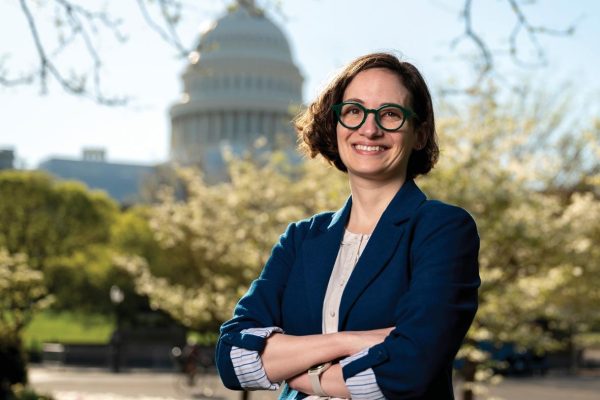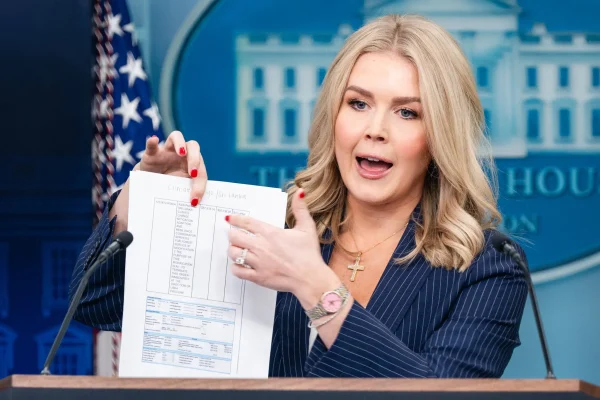
On Tuesday, Feb. 18, Associate Professor of Faculty Courtney Gibbons was terminated from her fellowship at the National Science Foundation (NSF) following an ongoing purge of the federal workforce by the Department of Government Efficiency (DOGE). At the NSF, Professor Gibbons worked on AI policy and computational neuroscience, the technology responsible for making AI intelligent. Furthermore, a private grant from the Howard Hughes Medical Institute to broaden participation in STEM was rescinded amongst cutbacks in federal grants.
At 9 a.m. on Feb. 18, Professor Gibbons received an email requiring her presence at a Zoom meeting with the Office of the Director of the NSF. The meeting, held at 10 a.m., informed her and approximately 10% of the NSF workforce that they were being terminated. At 11 a.m. her termination paperwork was sent, and only two hours later was she shut off from network access.
“It was surreal,” Gibbons told The Spectator. Terminated employees included fellows, like Professor Gibbons, as well as probationary employees, including some who were reclassified as probationary immediately before the meeting. According to Professor Gibbons, “I think a lot of people did not realize that they had been reclassified as probationary. They had negotiated, in some cases, had negotiated to come on without a probation period, and that’s what their contract said. And so even when you log in to the government website, where you can see your paperwork, it tells you whether or not you’re probationary or not. […] The folks in the meeting must have gotten some instructions to say those contracts are not really valid.”
“Like, of all the different types of employees that you could have let go, there’s a whole class who have temporarily come here from another job, and you could have chosen to let those people go, because at least they have a job to go back to. If you had to take the axe to some employees, why not those? And, again, the answer was like, well, OPM [Office of Personnel Management] gave us a stack of people and said, ‘these are the people,’ and I think it’s because they have the fewest legal protections,” Gibbons said.
Her termination is one of many nationwide as part of DOGE’s mass government downscaling under the Trump administration. Established on January 20th under an executive order named ESTABLISHING AND IMPLEMENTING THE PRESIDENT’S “DEPARTMENT OF GOVERNMENT EFFICIENCY.” Under the leadership of Elon Musk, the department has been systematically terminating employees from a number of government agencies, such as USAID or the Department of Education.
One recent effort in DOGE’s downsizing campaign is the requirement that all federal employees send in an email listing what they have done in the last week. According to NBC News, these emails are slated to be evaluated by AI, the area of Gibbons’ expertise and work within the NSF before her termination.
“What’s really troubling to me is to see these ideas like, ‘Oh, AI is going to find all this fraud, or AI is going to do this. AI is going to do that.’ These big claims about what AI is going to do to advance DOGE’s mission are really based on very little science. At the same time that the science that does actually make artificial intelligence more intelligent, or more fit for a certain purpose, or more fit for a certain mission, or more trustworthy for a specific use, [it is being] gutted, and the AI hype overlords are running rampant with all the data they can get. And it’s data that’s old. It’s data that has meaning and context that AI doesn’t understand,” said Gibbons.
With these cuts in funding, it will be more difficult for U.S. based researchers to keep up with international science agreements. Gibbons said, “I’m worried about how we can maintain, not even leadership, but presence in the global scientific community. We’ve made these memoranda of understanding, which are these formal agreements that we’re going to co-fund science with Germany, France and Japan, and suddenly we can’t hold our end of the bargain. Like, why would they ever want to work with us again in this collaborative way?”
Furthermore, without experienced staff members, uncut programs could still disappear. “It’s not like there was a lot of thought given to like, ‘Oh, this is the one person who’s been running this program for the last eight years and knows everything about it.’ So that program, even though it could exist without that person, probably won’t because no one has the institutional memory to keep it going,” Gibbons said.
Another aspect of downsizing is the federal grant and loan freeze memo given by President Trump on Jan. 27, which has since been rescinded and blocked by multiple judges. Despite this, some grants, both federal and private, have been discontinued, such as a Howard Hughes Medical Institute grant to Hamilton College. This private grant was meant to broaden participation in STEM, funding concentration events to build communities within departments.
“And they’re not federal. They’re just an entirely privately funded philanthropic organization. And I think many of us hoped that those types of organizations would step up, but instead they’re stepping back,” Gibbons said. She continued, “So for instance, at Hamilton, if I were to get a grant from NSF, some of that money would go to Hamilton, and that would pay for facilities. It would pay for the sponsored research officer we have that helps people get grants. It’s like part of what keeps the institution going and having the appropriate infrastructure and personnel to continue being a place where science can happen.”
When asked how the recent changes would affect students, Gibbons replied, “I don’t have a good sense of how it will affect students directly, aside from there may be fewer opportunities to work with faculty who are reliant on external funds. Hamilton does have some funds that can support student-faculty work, but I think faculty also have their attention kind of fractured right now between the major funders of the type of work that they do, the attacks on the things they care about and their community spaces on campus.”
“So I think, at least among faculty, what I’m afraid of is the feeling that Hamilton is kind of in a rural spot in the middle of New York state, but I had access to my research community through travel to meetings, through grant stuff, through all of these opportunities,” said Gibbons. “And without that, it feels really isolating to be at Hamilton. Where am I going to go to see my people, you know. I’m the one person in the department who does the research that I do… But like, how do I get to them, and how do I get my students in contact with them, and how do I maintain my own enthusiasm for that kind of work and find the energy to keep bringing students into it?”
